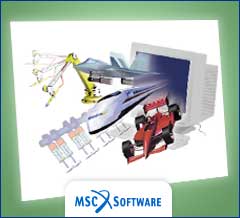|
Multibody
Dynamics A |
Description: Multibody Dynamics A is an introductory course in applied dynamics of mechanical systems. The emphasis is on the usage of multibody dynamics software. We want you to learn enough about dynamics in 3D that you will be able to use a standard multibody dynamics software package correctly, appreciate the limitations, and say some sensible things about the model at hand.
In the course you will learn about the fundamentals of Multibody Dynamics: the description of the orientation of a rigid body in space, the Newton-Euler equations of motion for a 3D rigid body, how to add constraints to the equations of motion, and how to solve such a system of coupled equations. You will spend most of the time (80%) in doing the lab assignments. These assignment consists of a number of practical problems that have to be worked out with the software package ADAMS. Your findings are to be put down in a Lab Report.
Goal: By the end of the course you be able to make a complex model of realistic 3D mechanical system and draw some conclusions from the dynamical analysis.
Grading: The written exam is of the open book type and has the form of a questionnaire about the findings as written down in your lab report. The report serves as reference material for your exam. At the end of the exam the questionnaire together with the Lab Report are to be handed over, The final grading is 50% on the report and 50% on the written exam.
News
8
May 2015: Final grades (Lab Report & Exam 16 apr 2015) are
available: Grades-wb1310-exam-16apr2015.pdf
18 Feb 2015: Final grades (Lab Report & Exam 22 jan 2015)
are available: Grades-wb1310-exam-22jan2015.pdf
Hand-Outs
- The course Contents.
- The Laboratory
Assignments.
- A short Introduction
to ADAMS (1,169 KB).
- Tire and Road files
for assignment#5 the Tractor: 16r26_new.tir,
18r38_new.tir, FlatRoad.rdf.
-
Tire and Road files for alternative assignment#5 the
Bicycle: bicycle600c.tir,
bicycle700c.tir, FlatRoad.rdf.
- Bicycle Benchmark paper: meijaard2007linearized.pdf
- Bicycle Science paper: kooijman2011bicycle.pdf
-
As an example the written exam from 20 june 2006: t20062006eng.pdf
Office
Hours
Instructor: Arend L.
Schwab, a.l.schwab@tudelft.nl,
Monday, 15-17 h., room F-0-010, phone: 015 278 2701.
TA: Sten Ponsioen, s.l.ponsioen@tudelft.nl,
Monday, 13-17 h. IO-PC hall 3 (SHIFT).
Lab Hours
On Monday's from 13-17 h. the TA will be in the IO-PC
hall 3 (SHIFT) at the Industrial Design Faculty (IO), to
assist you in doing the assignments and in the usage of the ADAMS
software.
Log
Week 1
Monday, 10 Nov, 2014, 13:45-15:30 u, room IO-PC hall 3 (SHIFT).
- Introduction.
I gave a short introduction about Multibody Dynamics and it's applications. Discussed the concept of rigid bodies with constraints and showed some 2D and 3D mechanisms and how to determine the number of degrees of freedom. Discussed redundant constraints and jamming. next I talked about Newton and Euler, and presented the Newton-Euler equations of motion for a rigid body in space. Talked about the Inertia tensor Ic, which changes due to the change in orientation of the body. As an example I calculated the torques applied at the bicycle wheel from assignment 2. First wrong and then right. Finally you should look at a rather nice derivation of the Newton-Euler equations of motion by means of the linear and angular momentum balance. See my slides from this lecture: Lecture1wb1310.pdf.
Week 2
Monday, 17 Nov, 2014, 13:45-15:30 u, room IO-PC hall 3 (SHIFT).
- Introduction.
Week 3
Monday, 24 Nov, 2014, 13:45-15:30 u, room IO-PC hall 3 (SHIFT).
- Modeling of mechanical systems.
Week 4
Monday, 1 Dec, 2014, 13:45-15:30 u, room IO-PC hall 3 (SHIFT).
- Modeling of mechanical systems.
Today I talked about assignment #4, the Governor. I discussed some aspects of the model; how to find the equilibrium angle at constant rpm. I showed some pages from "Higher Mechanics", by Horace Lamb, Cambridge University Press, 1920, which shows that in the absence of damping a centrifugal governor is unstable. This complies with the results you get for your model of the Governor in ADAMS for small damping. See my slides from this lecture: Lecture4wb1310.pdf.
Week 5
Thursday, 11 Dec, 2014,13:45-15:30 u, room IO-PC hall 3 (SHIFT).
- Modeling of mechanical systems.
Today I talked about assignment #5, the Tractor,
being put to the Mouse test. The modelling of the Tractor and the
operation (driving and steering along the course) is non-trivial. I
discussed these details, see my lecture notes for details: Lecture5wb1310.pdf
Next week (already Monday) I will the discuss the alternative assignment
#5: investigation into the lateral stability of a bicycle, or why
bicycles do not fall over given some forward speed. That will be a special
lecture on Bicycle Dynamics & Control. So those who want to
teh bicycle instead of the Tractor have to wait some days.
Week 6
Monday, 15 Dec, 2014, 13:45-15:30 u, room IO-PC hall 3 (SHIFT).
- special lecture on Bicycle Dynamics & Control.
Today I talked about the dynamics and control of
bicycles, for those who are interested in doing the alternative
assignment #5. But also for those who want to know about the strange
dynamics and control of the contraption which they use every day: the
Bicycle. Therefore the motto for today is: "Everybody knows how a
bicycle is constructed, yet few understand their operation."
Week 7
Wednesday, 7 Jan, 2015, 13:0-17:00 u, room IO-PC hall 3 (SHIFT).
- No lecture, only practical assistance..
Finally:
See you all at the written exam, Thursday 22 Januari 2015, 14-17 h, and please don't forget to bring each of you a copy of your lab report to the exam. This will serve as reference material and each of you have to hand in the copy of your lab report together with your written exam.
This is an example of a written exam: t20062006eng.pdf
SUCCES!

